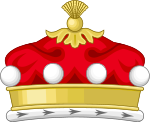| Barony Bethell | |
|---|---|
  Or, on a chevron azure an estoile of the first, in chief two boar’s heads couped of the second | |
| Creation date | 23 November 1922 [1] |
| Created by | King George V |
| Peerage | Peerage of the United Kingdom |
| First holder | Sir John Henry Bethell, 1st Baronet |
| Present holder | James Nicholas Bethell, 5th Baron Bethell |
| Heir apparent | Jacob Nicholas Douglas Bethell |
| Remainder to | Heirs male of the first baron's body lawfully begotten |
| Motto | Servabo fidem ("I will keep faith") |

Baron Bethell, of Romford in the County of Essex, is a title in the Peerage of the United Kingdom. It was created in the 1922 Dissolution Honours for the banker and Liberal politician Sir John Henry Bethell, 1st Baronet, who had represented the constituencies of Romford and East Ham North in the House of Commons. [2] [3] He had previously been created a baronet, of Romford in the County of Essex, on 26 June 1911. [1]
